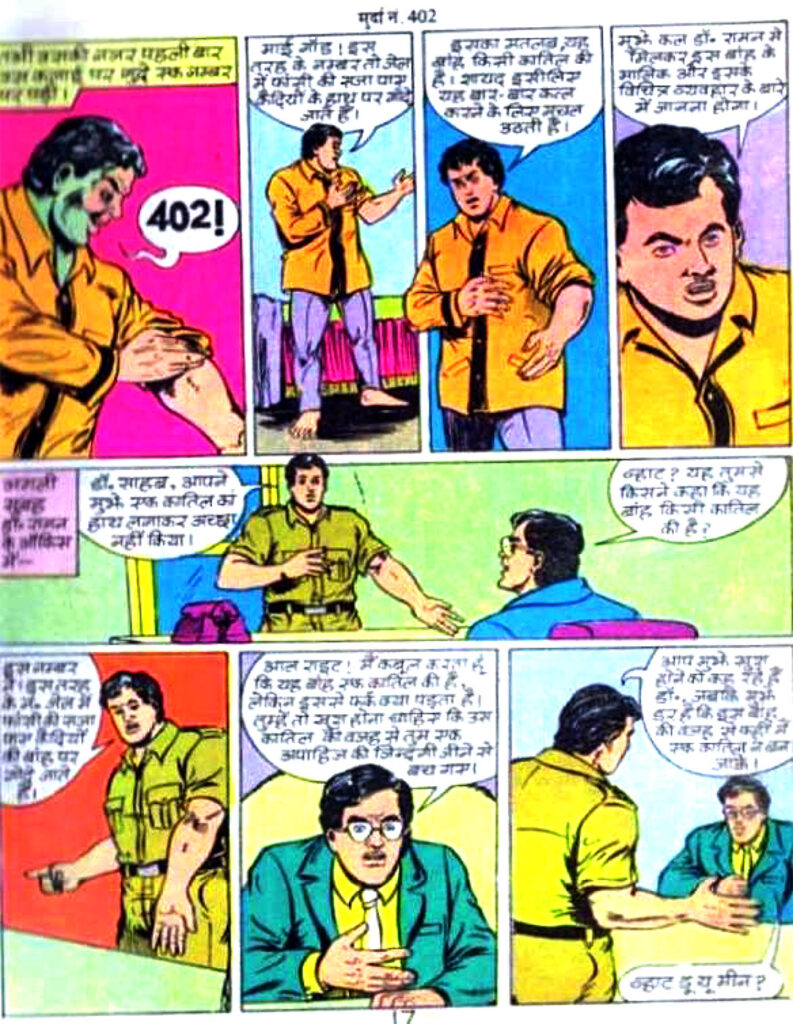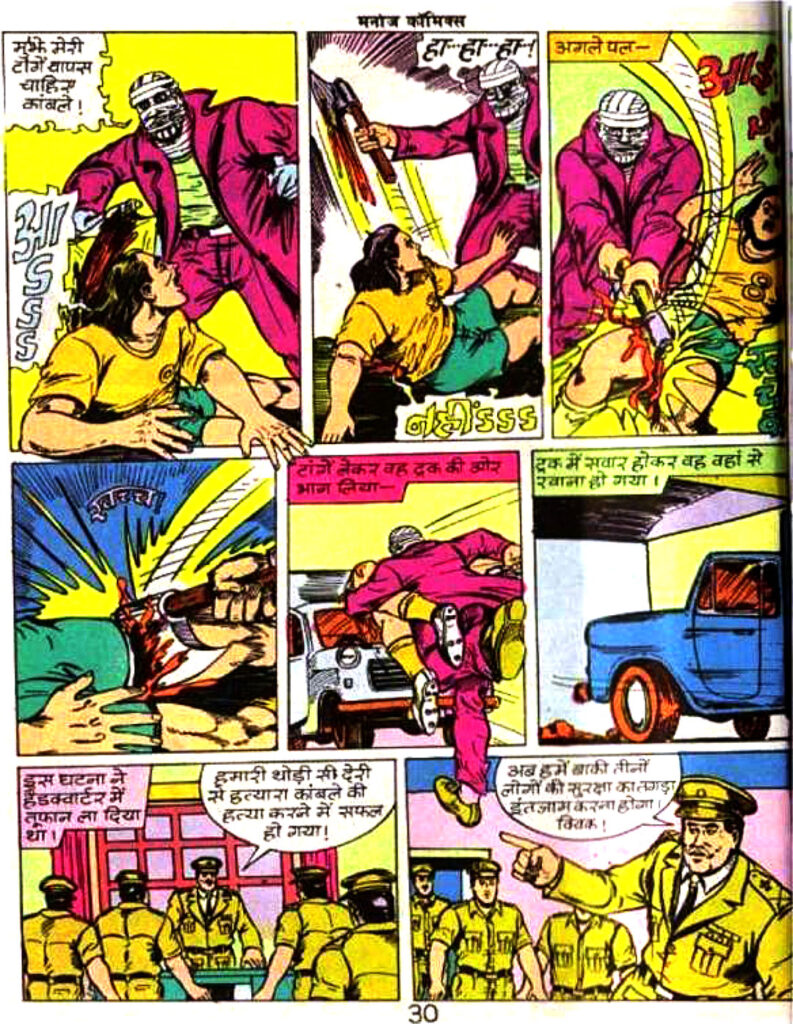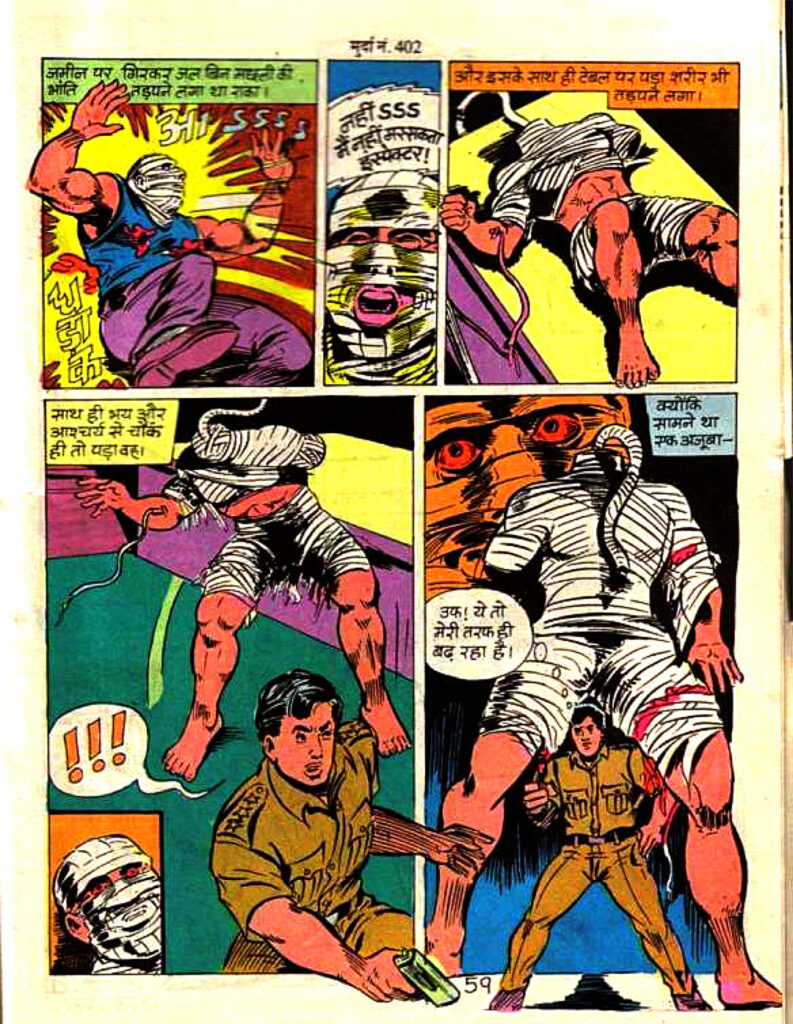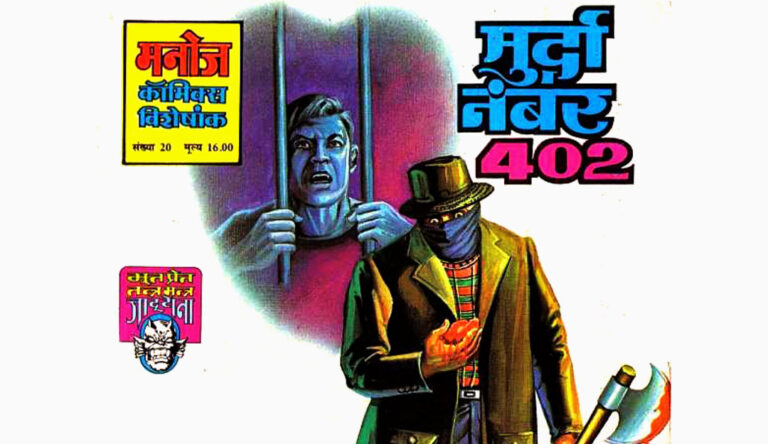Introduction
The nineties were the golden age of Indian comics. This was a time when children and teenagers held colorful comics in their hands instead of video game consoles or smartphones. While Raj Comics’ Nagraj and Super Commando Dhruv ruled the superhero genre, Diamond Comics’ Chacha Chaudhary and Billu were synonymous with family entertainment. In the same period, there was another publication that quietly yet firmly held its ground – Manoj Comics.
The specialty of Manoj Comics was its diversity. They offered a unique mix of horror, thriller, suspense, social, and detective stories. Their ghostly tantra-mantra series was another name for adventure and chills for the teenagers of that era. Today, we will talk about one such gem from the treasure trove of Manoj Comics – Murda No. 402(Corpse No. 402).
Priced at just 16 rupees and bundled with a free magnet sticker, the comic pulls the reader into its world right from the cover page. A sinister laugh, a diabolical figure, and a human heart in hand… this cover was enough to hint that a dangerous cocktail of fear, adventure, and mystery awaited inside.
Written by Najra Khan and illustrated by Naresh Kumar, this comic is as impactful today as it must have been at the time of its release. Let’s dive deeper into its story, characters, and artwork.
Plot
The story begins with a classic action scene. Our hero, Inspector Vikram Singh, is a brave and dutiful police officer who wreaks havoc on goons. In one such encounter, he is badly injured. A bullet strikes his hand, and poison begins to spread.
According to the doctors, his hand must be amputated to save his life. At this very moment of despair, Dr. Raman appears like a ray of hope. An expert in organ transplantation, he saves Vikram from disability by attaching the hand of a dead donor.

It seems like a medical miracle—but the real horror begins here. Back home, Vikram starts having terrifying nightmares and realizes that his new hand is not under his control. It turns him unruly and violent—so much so that one night he even tries to strangle his wife in his sleep. His own body becomes his enemy.
The mystery deepens when Vikram notices the number “402” engraved on the wrist of his new hand. Investigation reveals that it belonged to Murda No. 402(Corpse No. 402), a dreaded criminal who had been hanged. Vikram is unable to comprehend how the hand of a dead criminal can control him.
Meanwhile, a new bandaged-face criminal emerges in the city, known to the police as Raka. He is behind a series of gruesome murders—killing people and taking specific body parts. As the police panic, Vikram investigates the murders committed by Raka.
This quest eventually leads him into the sinister world of Dr.Norman, a satanic-minded scientist, where he uncovers a truth that defies science and logic. The climax takes place in this laboratory, where Vikram must fight not only his external enemies but also his own hand.
Character Analysis – Heroes, Villains, and Dark Science
Inspector Vikram Singh –
Vikram is the soul of the story. He begins as the perfect police hero—brave, honest, and powerful. But soon the storyteller pushes him into a deep psychological crisis. His portrayal is brilliant because he ceases to be just an action hero and becomes a man struggling for his identity, autonomy, and control over his own body.

Raka / Abdul –
Raka is a memorable villain. Not just physically brutal but mentally twisted as well. His concept of remotely controlling his old hand gives the comic a unique horror touch. He symbolizes how the misuse of science can become humanity’s greatest threat.
Dr. Norman –
Dr. Norman is the classic “mad scientist.” Blinded by his hunger for knowledge and power, he disregards human life. He is the story’s main conspirator, the root of all chaos. His character is reminiscent of Mary Shelley’s Frankenstein.
Other Characters –
Supporting characters like Vikram’s wife and son don’t get much space, but their presence is important. They represent the normalcy and humanity in Vikram’s life—the very things he is about to lose. The need to protect them gives him the strength to fight till the end.
Art and Illustration – Vintage Charm of the 90s
Naresh Kumar’s artwork is the heartbeat of this comic. His style perfectly reflects the classic Indian comic art of the 90s—bold lines, expressive faces, and dynamic action sequences.
Depiction of Action and Horror –
The action scenes have speed and intensity. Sound effects like Dhadak, Ah, Crash bring the panels to life. Horror sequences—especially when Vikram’s hand loses control or during his nightmares—are effectively drawn.
The color palette also plays an important role. Bright shades highlight action, while darker tones are used for suspense and fear.
Panel Layout –
The panel flow is smooth and easy to follow. The story moves without interruption. The artist uses close-up shots effectively, especially to capture facial expressions, letting readers feel the characters’ fear, anger, and pain directly.
Overall, the illustrations do full justice to the story. They may not be modern or sophisticated, but they carry a sincerity and charm often missing in today’s digital art.
Story and Screenplay – A Fusion of Science, Crime, and Superstition
Nazra Khan’s script is the strongest pillar of this comic. It successfully blends multiple genres—crime thriller, science-fiction horror, and psychological drama.
Unique Concept –
A transplanted organ still loyal to its original owner—this was a refreshingly scary idea for its time. It lifts the story from a simple horror tale into the realm of body horror, where fear comes not from outside but from within.

Pace and Thrill –
The script moves at a brisk pace. Every few pages bring a new twist or crisis, keeping the reader hooked. Vikram’s helplessness and Raka’s growing brutality create a constant tension until the climax.
Themes –
The story touches on important themes: the ethical use of science, the crisis of identity (are we just our bodies, or our consciousness?), and the eternal battle between good and evil—presented in a fresh and unique way.
Conclusion – Why Is Murda No. 402(Corpse No. 402) Still Worth Reading Today?
Murda No. 402(Corpse No. 402) is not just an old comic—it is a shining example of the creativity and storytelling of its era. It shows how, even with limited resources and simple art, a story could be both entertaining and thought-provoking.
For those who grew up in the 90s, this comic is a nostalgic delight. For new readers, it’s a fascinating glimpse into the depth and diversity of Indian comics.
Its story still has the power to grip readers with its mix of fear, adventure, action, and suspense.
In short, Murda No. 402 (Corpse No. 402) is a hidden gem from Manoj Comics, lost in the dust of time. If you come across it, don’t miss the chance to read it. It will transport you back to the golden era of Indian comics—when stories soared with imagination, and every page brought a new adventure.
